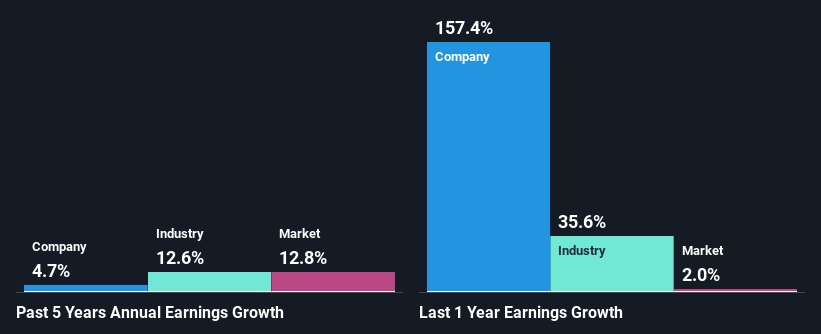- United States
- /
- Insurance
- /
- NYSE:WTM
White Mountains Insurance Group, Ltd.'s (NYSE:WTM) Stock Has Shown Weakness Lately But Financial Prospects Look Decent: Is The Market Wrong?

It is hard to get excited after looking at White Mountains Insurance Group's (NYSE:WTM) recent performance, when its stock has declined 2.3% over the past month. However, the company's fundamentals look pretty decent, and long-term financials are usually aligned with future market price movements. Particularly, we will be paying attention to White Mountains Insurance Group's ROE today.
Return on Equity or ROE is a test of how effectively a company is growing its value and managing investors’ money. In other words, it is a profitability ratio which measures the rate of return on the capital provided by the company's shareholders.
Check out our latest analysis for White Mountains Insurance Group
How To Calculate Return On Equity?
ROE can be calculated by using the formula:
Return on Equity = Net Profit (from continuing operations) ÷ Shareholders' Equity
So, based on the above formula, the ROE for White Mountains Insurance Group is:
15% = US$771m ÷ US$5.3b (Based on the trailing twelve months to September 2024).
The 'return' is the amount earned after tax over the last twelve months. So, this means that for every $1 of its shareholder's investments, the company generates a profit of $0.15.
Why Is ROE Important For Earnings Growth?
So far, we've learned that ROE is a measure of a company's profitability. Depending on how much of these profits the company reinvests or "retains", and how effectively it does so, we are then able to assess a company’s earnings growth potential. Assuming all else is equal, companies that have both a higher return on equity and higher profit retention are usually the ones that have a higher growth rate when compared to companies that don't have the same features.
White Mountains Insurance Group's Earnings Growth And 15% ROE
To start with, White Mountains Insurance Group's ROE looks acceptable. Even when compared to the industry average of 14% the company's ROE looks quite decent. Despite the modest returns, White Mountains Insurance Group's five year net income growth was quite low, averaging at only 4.7%. We reckon that a low growth, when returns are moderate could be the result of certain circumstances like low earnings retention or poor allocation of capital.
As a next step, we compared White Mountains Insurance Group's net income growth with the industry and were disappointed to see that the company's growth is lower than the industry average growth of 13% in the same period.

Earnings growth is a huge factor in stock valuation. What investors need to determine next is if the expected earnings growth, or the lack of it, is already built into the share price. By doing so, they will have an idea if the stock is headed into clear blue waters or if swampy waters await. One good indicator of expected earnings growth is the P/E ratio which determines the price the market is willing to pay for a stock based on its earnings prospects. So, you may want to check if White Mountains Insurance Group is trading on a high P/E or a low P/E, relative to its industry.
Is White Mountains Insurance Group Making Efficient Use Of Its Profits?
A low three-year median payout ratio of 0.5% (implying that the company retains the remaining 100% of its income) suggests that White Mountains Insurance Group is retaining most of its profits. This should be reflected in its earnings growth number, but that's not the case. So there might be other factors at play here which could potentially be hampering growth. For example, the business has faced some headwinds.
In addition, White Mountains Insurance Group has been paying dividends over a period of at least ten years suggesting that keeping up dividend payments is way more important to the management even if it comes at the cost of business growth.
Conclusion
In total, it does look like White Mountains Insurance Group has some positive aspects to its business. Although, we are disappointed to see a lack of growth in earnings even in spite of a high ROE and and a high reinvestment rate. We believe that there might be some outside factors that could be having a negative impact on the business. While we won't completely dismiss the company, what we would do, is try to ascertain how risky the business is to make a more informed decision around the company. To know the 1 risk we have identified for White Mountains Insurance Group visit our risks dashboard for free.
Valuation is complex, but we're here to simplify it.
Discover if White Mountains Insurance Group might be undervalued or overvalued with our detailed analysis, featuring fair value estimates, potential risks, dividends, insider trades, and its financial condition.
Access Free AnalysisHave feedback on this article? Concerned about the content? Get in touch with us directly. Alternatively, email editorial-team (at) simplywallst.com.
This article by Simply Wall St is general in nature. We provide commentary based on historical data and analyst forecasts only using an unbiased methodology and our articles are not intended to be financial advice. It does not constitute a recommendation to buy or sell any stock, and does not take account of your objectives, or your financial situation. We aim to bring you long-term focused analysis driven by fundamental data. Note that our analysis may not factor in the latest price-sensitive company announcements or qualitative material. Simply Wall St has no position in any stocks mentioned.
About NYSE:WTM
White Mountains Insurance Group
Through its subsidiaries, provides insurance and other financial services in the United States.
Adequate balance sheet very low.
Similar Companies
Market Insights
Community Narratives



